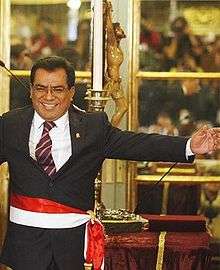Javier Velásquez
Ángel Javier Velásquez Quesquén (born March 12, 1960) is a Peruvian lawyer and politician. A prominent member of the Peruvian Aprista Party, he has served in Congress since 2001, previously serving from 1995 to 2000. In Alan García's second presidency, Velásquez was sworn as the third Prime Minister of Peru of the administration, succeeding Yehude Simon in 2009.[1] He resigned his post in 2010 with the intention to run for the Peruvian Aprista Party presidential nomination later that year. Although not elected as the nominee, he was part of the presidential ticket of Mercedes Aráoz until her withdrawal from the election in January 2011. In 2016, he was reelected for a fifth term in Congress, representing the Lambayeque Region for the APRA-PPC alliance.
Javier Velásquez Quesquén | |
|---|---|
 | |
| Chairman of the Peruvian Aprista Party Political Commission | |
| In office March 5, 2010 – July 8, 2017 | |
| President | Alan García |
| Preceded by | Mercedes Cabanillas |
| Succeeded by | Mauricio Mulder |
| Prime Minister of Peru | |
| In office July 11, 2009 – September 14, 2010 | |
| President | Alan García |
| Preceded by | Yehude Simon |
| Succeeded by | José Antonio Chang |
| President of Congress | |
| In office July 26, 2008 – July 11, 2009 | |
| Preceded by | Luis Gonzales Posada |
| Succeeded by | Alejandro Aguinaga |
| Member of Congress | |
| In office July 26, 2001 – September 30, 2019 | |
| Constituency | Lambayeque |
| In office July 26, 1995 – July 26, 2000 | |
| Constituency | National |
| Personal details | |
| Born | March 12, 1960 Etén, Peru |
| Nationality | |
| Political party | Peruvian Aprista Party |
| Spouse(s) | Jenny Obando Popuche |
| Alma mater | Pedro Ruiz Gallo National University (LLB) Pontifical Catholic University of Peru (LLM) University of the Pacific (MPA) National University of San Marcos (Ph.D. candidate) |
| Occupation | Politician |
| Profession | Lawyer |
Law career
In 1987, Velásquez graduated with a law degree from the National University Pedro Ruiz Gallo. Since that year, he has been a designate lecturer at the Higher Institute of Technology "República Federal de Alemania" in Chiclayo. From 1991 to 1992, he was head of the public register of the North Eastern region of Marañón. From 1997 to 2003 he additionally studied for a Master of Laws, focusing on Constitutional law at the Pontifical Catholic University of Peru. Velásquez was a lecturer (Professor) at the Private University Chiclayo in 2000/2001 and at the University of San Martín de Porres in 2006 and in 2007/2008, teaching constitutional law.
Currently he is studying to obtain a Ph.D. in Law from the prestigious National University of San Marcos in Lima.
Political career
Javier Velásquez started his career in the social-democratic Peruvian Aprista Party, serving as Secretary General of the Party's base in Lambayeque from 1992 to 1994. In 1995, he was elected to the Congress for his first five-year term, being re-elected in 2001, 2006 and 2011. From 1999 to 2004 he was Vice-Chair of the Political Commission on the Party. In June 2004 he presided the organizing committee for the XXII National Congress of the Party, at which he was elected to the national Political Steering Committee. He served as the President of the Congress from 2008 to 2009.[2] From March 2010 to July 2017, he served as Chairman of the party's Political Commission.
Premiership
On 11 July 2009, President Alan García named him as prime minister during the controversy surrounding indigenous clashes with the government when 34 people died.[3] He was sworn-in at 8:00 pm on 12 July 2009. The appointment of Velásquez, considered a party loyalist, was seen by pundits as an attempt by García to tighten his grip on power for his final term. It is considered a reversal after appointing the leftist Yehude Simon, Velásquez's predecessor.[4] Velásquez is the third person to hold the office in nine months.[5] Garcia, whose approval rating was 21 percent,[3] also replaced the ministers of defense, justice, agriculture and the interior.[6]
Party insider
Velásquez is considered a governing party insider, having served in Congress for 20 years.[5][7] He is thought to be an adept negotiator with a powerful rhetoric in defense of his leader Alan García. He was reelected for a fifth term in Congress at the 2016 general elections.[3]
His final tenure in office ended with the dissolution of Congress by Martín Vizcarra. He served a total of 23 years in Congress.
References
| Wikinews has related news: |
- Emery, Alex (July 11, 2009). "Peru's Garcia Names New Cabinet Chief After June Protests". Bloomberg. Retrieved 2009-07-11.
- http://www.congreso.gob.pe/participacion/museo/congreso/presidentes/angel_velazques
- Aquino, Marco (July 11, 2009). "Peru's Garcia to name party insider prime minister". Reuters. Thompson Reuters. Retrieved 2009-07-11.
- AFP (July 11, 2009). "Peru names new prime minister". AFP. Google. Retrieved 2009-07-11.
- Briceno, Franklin (The Associated Press) (July 11, 2009). "Peru's leader shakes up his Cabinet amid protests". Google. Associated Press. Archived from the original on January 8, 2009. Retrieved 2009-07-11.
- Aquino, Marco; Wade, Terry (July 11, 2009). "Peru's Garcia names party insider prime minister". Boston.com. Reuters via The New York Times Company. Retrieved 2009-07-11.
- Collyns, Dan (July 12, 2009). "Peru president reshuffles cabinet". BBC News. Retrieved 2009-07-11.
External links
| Wikimedia Commons has media related to Javier Velásquez. |
- Official Congressional Site
- Presentation on the Peruvian Aprista Party site
- Resume on the National Electoral Panel (JNE) site
| Political offices | ||
|---|---|---|
| Preceded by Luis Gonzales Posada |
President of the Congress of Peru 2008–2009 |
Succeeded by Alejandro Aguinaga |
| Preceded by Yehude Simon |
Prime Minister of Peru 2009–2010 |
Succeeded by José Antonio Chang |